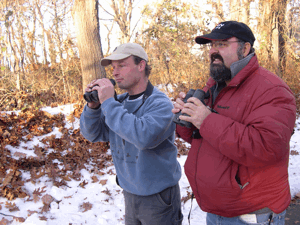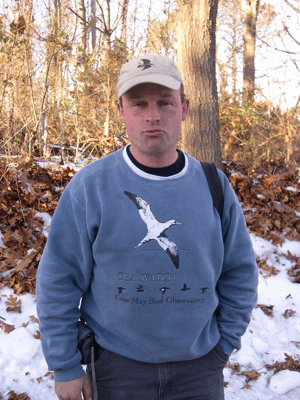Bird Whistler
Air Date: Week of February 5, 2010

Patrick Dugan and his friend Frank Gallow go birding. (Photo: Laurie Sanders)
Patrick Dugan likes to go birding. But he doesn't have to use high tech smartphone apps to attract birds. All Dugan has to do is put his lips together and blow. Producer and naturalist Laurie Sanders has a profile of Patrick Dugan, bird whistler extraordinaire.
Transcript
YOUNG: Bird watching as a hobby dates back to the late 1800s, when studying birds for their looks and behavior became more fashionable than hunting them for food. These days, advances in technology have revolutionized birding – from high tech binoculars to smart phone apps that can play recordings of bird songs to try to lure them in. But some birders have their own special ways to attract our feathered friends. Producer and naturalist Laurie Sanders has this profile.
[TREE SPARROW SOUNDS]
SANDERS: Hear those tree sparrows? Well, actually those aren’t real tree sparrows. It’s Patrick Dugan.
DUGAN: There’s one, two, three, four, five, six of them – six of them came in.
GALLOW: It works, he did tree sparrow and six of them popped up out of the bush and came over to us. [LAUGHS] It’s like having a tape recorder, just walk along and push play.
SANDERS: On this windy day, Patrick Dugan and his friend, Frank Gallow are birding along the edge of a small patch of woods at Lighthouse Point in New Haven, CT. Patrick Dugan is a phenomenon. He has perfect pitch, and during his 20 years of birding, he’s memorized more than 1,000 bird songs and can now imitate well over 100 songs and call notes.
He and Gallow routinely lead birding trips together. And over the years, they’ve participated in dozens of bird counts—including the world series of birding in New Jersey, where the goal is to find as many species as possible in a 24-hour period. At these events, Gallow says Dugan’s uncanny skills are a huge advantage.
GALLOW: The more tuned your ear is, and Pat has an amazing ear, the more species you can count. So, you have to practice and practice and practice. His ability to reproduce chirp notes, both as a reminder to himself, but also on some occasions he actually can get the birds to call back to him. So he’ll chirp into a bush where we think we saw a white crowned sparrow, and it’ll pop up and chirp back at him.

Bird whistling expert Patrick Dugan. (Photo: Laurie Sanders)
[BIRD CHIRPS]
SANDERS: Dugan’s interest in birds began in his early 20’s when his brother took him bird watching. After seeing a scarlet tanager, he was hooked. What appealed to him was the challenge of finding and identifying birds, especially the trickier groups like gulls and shorebirds, sparrows and flycatchers (species that visually resemble each other, but can often be more easily separated by their songs and call notes).
And so, Dugan—who was a precocious whistler, beginning when he was just a toddler—began trying to imitate the sounds he was hearing.
DUGAN: Well start basically by whistling.
[DUGAN WHISTLES]
DUGAN: Start with that. Then set releasing and pressuring the lips.
[HIGHER PITCH WHISTLE]
DUGAN: That’s all different movements of the lips.
[CONTINUES WHISTLE]

Patrick Dugan and his friend Frank Gallow go birding. (Photo: Laurie Sanders)
SANDERS: And then he says you start moving your tongue back and forth and working on controlling the air pressure as it moves between your teeth.
DUGAN: It all depends on the tones that I do it in, the speed that I do it in.
[DUGAN QUICKLY WHISTLES DIFFERENT TONES]
DUGAN: Or slower.
[DUGAN WHISTLES A SLOWER, DEEPER WHISTLE]
DUGAN: Or, it depends on the birds. You know, buzzy like prairie warbler
[DUGAN WHISTLES ABUZZING WHISTLE]
DUGAN: Or black throated blue
[DUGAN WHISTLES SHORT WHISTLE]
DUGAN: Or black throated green.
[DUGAN WHISTLES A MANY-TONED WHISTLE]
SANDERS: For much of his adult life, Dugan was able to practice his whistling at his job. For years, he was a picture framer, working alone in the shop’s basement, where he listened to recorded bird songs and practiced imitating them. And he practiced and practiced.
The most complex song he whistles is that of the winter wren, which took him over six months to perfect.
[DUGAN WHISTLES THE WINTER WREN CHIP]
[SANDERS LAUGHS]
DUGAN: It makes me smile every time.
SANDERS: A few years ago, Dugan’s remarkable ability came to the attention of Woody Allen, who asked him to audition for the talent show scene in the movie “Sweet and Low Down,” featuring Sean Penn.
DUGAN: I went in, they filmed me, Woody Allen said, “Here stand here, do three birdcalls, do the name then the calls, when I say action go.” So I did. I did scarlet tanager, white-throated sparrow and barred owl. And I was there for about 13 hours, or so, and then they cut me. Apparently, they wanted someone more funny.
GALLOW: Yeah, tell her the real reason. The real reason was he was just too good, and Sean Penn was supposed to win the talent contest and wouldn’t have won had he actually competed against Patrick, so they had to cut him.
SANDERS: To get out of the wind, we duck into Dugan’s car, and I ask him to whistle. And taking a breath, he begins his repertoire.
[DUGAN MAKING ALL DIFFERENT BIRD SOUNDS]
SANDERS: For Living on Earth, I’m Laurie Sanders
[BIRD SOUNDS CONTINUE]
Living on Earth wants to hear from you!
Living on Earth
62 Calef Highway, Suite 212
Lee, NH 03861
Telephone: 617-287-4121
E-mail: comments@loe.org
Newsletter [Click here]
Donate to Living on Earth!
Living on Earth is an independent media program and relies entirely on contributions from listeners and institutions supporting public service. Please donate now to preserve an independent environmental voice.
NewsletterLiving on Earth offers a weekly delivery of the show's rundown to your mailbox. Sign up for our newsletter today!
 Sailors For The Sea: Be the change you want to sea.
Sailors For The Sea: Be the change you want to sea.
 The Grantham Foundation for the Protection of the Environment: Committed to protecting and improving the health of the global environment.
The Grantham Foundation for the Protection of the Environment: Committed to protecting and improving the health of the global environment.
 Contribute to Living on Earth and receive, as our gift to you, an archival print of one of Mark Seth Lender's extraordinary wildlife photographs. Follow the link to see Mark's current collection of photographs.
Contribute to Living on Earth and receive, as our gift to you, an archival print of one of Mark Seth Lender's extraordinary wildlife photographs. Follow the link to see Mark's current collection of photographs.
 Buy a signed copy of Mark Seth Lender's book Smeagull the Seagull & support Living on Earth
Buy a signed copy of Mark Seth Lender's book Smeagull the Seagull & support Living on Earth

